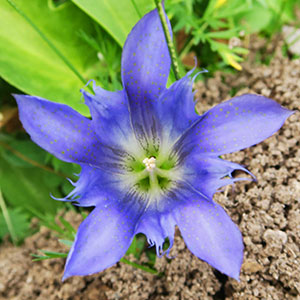Gentiana newberryi
Gentiana sceptrum
alpine gentian, Newberry's gentian
King gentian, King's gentian, King's scepter gentian, King's-scepter or staff or Pacific gentian, staff gentian
1–5, arising laterally below rosettes, from a stout tap root, tufted, decumbent.
1–4(–10), terminal from caudex, decumbent to erect.
basal and cauline;
blades of basal rosette and proximal cauline leaf blades widely spatulate to obovate or oblanceolate, 0.8–5 cm × 2–25 mm, apex obtuse or mucronate, at least these leaves with blades less than 6 times as long as wide, distal cauline leaves few, with blades oblanceolate to lanceolate or linear, 2–5 cm × 2–5 mm, apices acute.
cauline, gradually more widely spaced distally;
blade lanceolate to ovate or elliptic, 1–9 cm × 5–15(–20) mm, apex obtuse to acute.
terminal, flowers usually solitary, occasionally 2 or 3.
solitary flowers or 2–5-flowered heads or umbellate cymes, often also on peduncles to 8 cm or in cymules on branches from distal 1–4(–7) nodes.
calyx 14–30 mm, lobes linear to narrowly ovate, (4–)6–12 mm, margins not ciliate;
corolla white or blue, campanulate, open, 23–55 mm, lobes spreading, elliptic-obovate, 7–17 mm, free portions of plicae divided into 2 triangular, serrate to lacerate segments;
anthers distinct.
calyx 13–27 mm, tube rarely deeply cleft, lobes lanceolate to elliptic-ovate or rarely foliaceous, 6–15 mm, margins not ciliate;
corolla blue or rarely rose-violet or white, narrowly campanulate, opening only slightly with lobes ascending to incurved, 25–50 mm, lobes oblong-ovate to orbiculate, 5–10 mm, summit of plicae forming ± truncate, entire sinus, not or scarcely extending beyond bases of lobes;
anthers distinct.
winged.
winged toward ends only.
= 26.
Gentiana newberryi
Gentiana sceptrum
Varieties 2 (2 in the flora).
The two varieties of Gentiana newberryi intergrade extensively. The most distinctive form of var. newberryi, with relatively tall stems and medium to deep blue corollas, occurs in the northern part of the range of the species, from the Klamath and White mountains of California north into Oregon. Plants most clearly referable to var. tiogana prevail in the southern part of the range of the species, from Butte County south to Inyo and Tulare counties, California. In the central part of the range of the species, plant size and corolla color are less consistently correlated, with occasional plants combining low stature with deep blue corollas or tall stems with predominantly white or pale blue corollas. In that part of the range, corolla color may be highly variable within a single population.
The leaves of Gentiana newberryi are thick-textured and distinctively concave, usually spoon-shaped, when fresh. Narrower leaves sometimes occur in var. tiogana, but many plants of that variety have widely spatulate leaves like those of var. newberryi.
(Discussion copyrighted by Flora of North America; reprinted with permission.)
Plants of Gentiana sceptrum with ascending, narrowly lanceolate leaves conspicuously exceeded by the distal internodes have been called G. menziesii. Plants with spreading, elliptic to ovate, more closely spaced leaves have been called G. sceptrum var. cascadensis, although that variant might more appropriately be considered nomenclaturally typical. Studies for this flora have indicated that the extremes are connected by many intermediates, and that little correlation exists between leaf shape and geographic distribution, or between leaf shape and the other traits by which the segregates have been characterized, such as stature, erectness of stems, or numbers and sizes of flowers. Even within a relatively limited area, such as Vancouver Island, British Columbia, or Humboldt County, California, plants can be found with leaves ranging from narrowly lanceolate to widely elliptic.
Small plants with strongly decumbent stems, found at a few localities at or near the coast in California and southern Oregon, have been called Gentiana sceptrum var. humilis. Spathaceous calyces occasionally occur in these plants. Such plants are not recognized taxonomically here because larger plants approaching typical G. sceptrum have been found at the same localities or nearby, but they should be given further study.
(Discussion copyrighted by Flora of North America; reprinted with permission.)
1. Corollas medium to deep blue with greenish to dark purple lines abaxially on and below lobes, usually 35–55 mm. | var. newberryi |
1. Corollas white to pale blue except for greenish to dark purple lines abaxially on and below lobes, usually 23–42 mm. | var. tiogana |
- Local floras:
BC,
CA,
OR,
WA
- Local Web sites:
CalFlora,
CalPhotos,
Flora NW,
PNW Herbaria,
Turner Photog.
WildflowerSearch
iNaturalist (observations)
USDA Plants Database
- LBJ Wildflower Center
- SEINet
- Plants of the World Online
- Encyclopedia of Life
- Wikipedia
- Google Image Search


